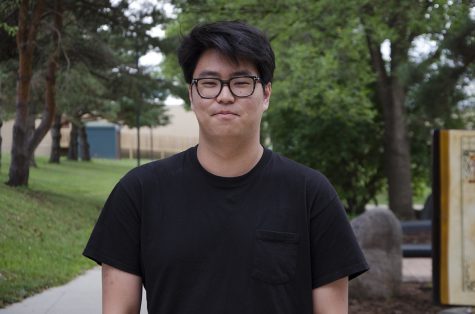Waste.
As the participation in environmental activism at West decreases, West Side Story offers some food for thought before you throw your scraps into the trash.
If given a waste bin, a recycling bin and a compost bin in the cafeteria, most students don’t think about where the trash should go. Trash is trash, right?
Everyone, even the most environmentally conscious people, can be victims of this line of thinking. However, this attitude is what drives food waste in high schools nationally. Discarded food has increased by 56 percent from 2012 in American high schools and at West, students waste approximately 15 percent of the food that they take from the cafeteria.
Until about a decade ago, this number was much higher. Julie Peterson, head of the kitchen staff at West High, recounts her first experiences working in the kitchen.
“I’ll never forget my first week here. You come in and you watch your employees; my head cook came and there was a stack of buns, about 400 or so, and it all just went straight in the trash,” Peterson said.
Recognizing the waste problem in the kitchen, Peterson began making changes to the cooking process. Now, the kitchen staff meticulously collects data to accurately measure the amount of food needed per day, virtually eliminating wasted food. Each day, the cooks keep track of how many portions of each food item are taken and how many are left over. Based on that data, the kitchen staff makes modifications to the next day’s preparations; for instance, if two portions of salad are left over, then the cooks prepare two less portions for the next day.
In addition, cooks now use a process called batch cooking where food is made in small batches during the lunch periods instead of being made en masse beforehand. Because of the smaller batches, the portions of cooked food are closer to the portions sold, which allows the uncooked material to be stored for future use. On top of all of this, the kitchen staff account for fluctuations when a more popular lunch item such as popcorn chicken or orange chicken is served. In response, they make sure to cook more of the popular items, and less of the undesired ones.
Even when the data is off and food gets left over, the kitchen staff makes sure that none of it is wasted. Most of the leftover food from the kitchen at West is taken to nearby elementaries and junior high schools to be offered the following day, and the kitchen composts any other wasted food. With the help from grants from local environmental leader Scott Koepke and students in special education programs who transport the waste, the kitchen staff is able to compost daily.
Steve Merkel, special education teacher at West High, puts in a great deal of effort to assure that composting occurs at West as well. In the early days of the composting program, he would often have to take all the discarded kitchen scraps to the landfill himself in the back of his truck.
“We used to joke that if Dr. Shoultz ever got someone to replace me it’d have to be someone with a pickup truck,” he said. “Fortunately now that wouldn’t have to be the case.”
Now, others, including manager Scott Koepke at the New Pioneer Co-op, have stepped up to help transport the waste, with the waste first being sorted through each day to ensure all parts are compostable.
Fortunately, the West high staff has been accepting of new proposals; the kitchen composting program serves as a testimony to this open-minded attitude. According to Merkel, this kind of willingness is the primary reason why food waste has decreased tremendously in the past few years.
“It’s not that the staff don’t want to save the world, but you have to be real about it. They’re on the clock, they still have to sweep all the floors and pick up other stuff, and you can’t always expect them to compost too,” Merkel said. “But they do.”
Since the waste in the kitchen is practically zero, the one glaring flaw lies with the student body. According to various sources, including the University of Arizona’s Garbage Project study, notable environmental author Tristram Stuart, TIME magazine, and the Food and Agriculture Organization of the United Nations, approximately 1.3 billion tons of food are wasted per year and account for 19 percent of waste in landfills, where it produces methane and over four million tons of carbon dioxide. Despite these harmful impacts, food waste awareness and general environmental awareness is low. In fact, even though composting can regenerate some of the 40 percent of the world’s degraded agricultural topsoil, only around 5 percent of food is composted worldwide.
This global lack of composting and general environmental awareness can be seen at a smaller level at West High. Despite the roughly 148 pounds of food that are wasted per day, there are only three students in the environmental club EATS. This is a dramatic decline from just four years ago when the club was first created and the number of students was closer to twenty. Even then, the students involved in the club generally had environmentally conscious parents or some sort of environmental background that prompted them to join the club. This was especially true for then president of the club Kate Anstreicher ’14, who recalls that she even took her trash home to be composted at her house.
“I was first introduced to it at home. [My parents] were aware of the rewards of compost and alternative agriculture,” Anstreicher said. “Food waste is just, in my opinion, a no-brainer. There are no possible consequences of diverting food waste. There are only benefits economically and environmentally.”
In her years in EATS, Anstreicher was instrumental in establishing the kitchen composting program that persists to this day. Despite these successes, she recalls the difficulty of educating the rest of the student body. In an attempt to mirror the composting in the kitchen, EATS and Anstreicher put compost bins alongside the recycling and the trash and had their members direct trash to the appropriate bins. However, the procedure was impossible to implement as students would often spread out throughout the building to eat.
“So many [students] were rushing from lunch to class,” Anstreicher said. “It’s hard because West High is so overpopulated that you have people eating in the hallways and not even using trash bins or potential compost bins.”
The problem became worse when EATS members weren’t available to supervise the composting process. Anstreicher said that members often had schoolwork to make up during a lunch period or sat with their friends during lunch, making the overwhelming student population even less manageable. She recalls that she was sometimes the only person overseeing the compost bins in the cafeteria.
“I think for something like food diversion to succeed you need a core group of people,” Anstreicher said, “Obviously if there is some form of advertising for it, it could help.”
EATS never found a long term solution that didn’t involve a club member supervising students during the lunch periods. It wasn’t long before the compost bins were removed from the cafeteria, and no procedure to decrease student waste has been put in place since. With only the recycling and the trash bins left, food waste remains at the same levels as before.
Although environmental activism and EATS membership have declined since then, there are potential structural changes that may decrease food waste regardless of the awareness. For instance, a University of Vermont study showing the detrimental impacts of certain school lunch regulations raises the question of a federal regulation reform. These regulations, which require students to take a half cup of fruit or vegetables at lunch, were passed in 2010 and took effect in 2012 as part of the Healthy, Hunger-Free Kids Act. The study showed that, although the regulation forced more students to take a fruit or a vegetable, most of the healthy options were thrown in the trash, creating more waste than before. It cited the new regulations as increasing food waste in schools by 56 percent.
Despite these findings, there is other evidence that suggests that the food waste increase is minimal, most notably a Harvard study which claimed that students tend to eat the required healthy options given that they have more than 25 minutes to eat lunch. West High Principal Gregg Shoultz agreed that while there were students who threw the fruits and vegetables away, the pros outweighed the cons.
“[Without these guidelines] you might see students not eating fruits or vegetables. These nutritional guidelines are there for a reason. If you don’t give students other [junk food], they will eat the [nutritious] stuff.”
At a local level, West High’s food waste problem may become much more manageable when Liberty High officially opens, addressing West’s overpopulation problem. Since student composting attempts failed because of the unmanageable number of students compared to the small number of people in EATS, reducing the student population by 500 to 600 students reopens the door for composting programs and other student environmental initiatives that were previously impossible. The population decrease would also help contain students in the cafeteria during lunch periods, making it easier to oversee student waste. Along with the opening of Liberty High, West’s cafeteria remodel for the coming school year may decrease waste even without new environmental initiatives. The remodel will employ multiple stations, rather than one single line, attempting to make it easier for students to take more of what they want and throwing away less.
Despite these changes that may make it easier to monitor student waste, activism remains the heart of the issue. Mara Jensen ’17 and Kalei Strabala ’17, the current presidents of EATS and two of the three members of the club, noted that the club wasn’t able to do much this year. Although the club members have a garden behind the baseball field where they grow food and send it to the kitchen, Strabala gave a stifled laugh when asked how much food EATS is able to produce. “Not very much,” Strabala remarked. “We don’t have enough people to produce enough and we only have a certain amount of garden space.”
However, the club has been attempting to attract more students and has been doing community outreach. According to Jensen, the club promotes movie days and game days to draw more people in and has cooking days using EATS-grown ingredients. Jensen and Strabala continue to encourage more people to join, hoping for big environmental payoffs in the future.
“I think [EATS] will be powerful if we start growing bigger and if we start trying to make a big impact. We need more people and we need people who want to preserve the environment,” Jensen said.
Anstreicher hopes that environmental outreach will go even further into the elementary and junior high school levels, and work to inspire generations of environmentally active students. Knowing that she was one of the beneficiaries of having early exposure to composting and general environmentalism, she hopes that early education will give students the opportunities that she gained through EATS, a club that Anstreicher remembers is one of the fondest memories from West High.
“I think the first step is early education. The earlier people are learning about these issues the more automatic the response is. Teaching kindergarteners to compost versus teaching high schoolers is a whole different ball game. Their brains are a lot more malleable and they also take the information home to their parents,” Anstreicher said. “We’re from Iowa, which is one of the most agricultural states in the country, and I think it would be cool to learn about our crops and the topsoil.”
As for now, students can think about what they can do to reduce the 15 percent of West food that gets wasted daily. They can also think about how to reduce waste at home, whether it be as simple as eating leftovers or as complex as starting a home compost bin. As Dr. Shoultz sums up, simply being aware of a particular problem is often key:
“All of us, students and teachers, zero in on our daily lives, and we need to say, ‘What are we doing about it?’”
Your donation will support the student journalists of West High School. Your contribution will allow us to purchase Scholarship Yearbooks, newsroom equipment and cover our annual website hosting costs.

Will Conrad is a reporter, anchor, and Assistant Sports Editor for Print. This is his third year on staff. In his free time he enjoys running, being outdoors,...

This is Junhee's third year on the West Side Story staff. He would greatly appreciate it if you go to the homepage (wsspaper.com) and...




